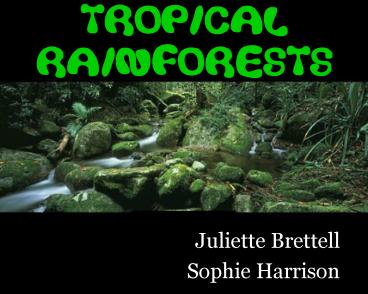TROPICAL RAINFORESTS - PowerPoint PPT Presentation
1 / 22
Title:
TROPICAL RAINFORESTS
Description:
TROPICAL RAINFORESTS. Juliette Brettell. Sophie Harrison. PLANT ADAPTATIONS. BARK ... Sweet or foul-smelling nectar in the pitcher to attract insects ... – PowerPoint PPT presentation
Number of Views:115
Avg rating:3.0/5.0
Title: TROPICAL RAINFORESTS
1
TROPICAL RAINFORESTS
- Juliette Brettell
- Sophie Harrison
2
PLANT ADAPTATIONS
3
BARK
- Thinner smoother bark to allow for moisture
evaporation - Prevents other plants growing up the trees trunk
- Exfoliates regularly to shed epiphytes
4
LIANAS(Climbing Vines)
- Roots in the ground
- Climb trees into the canopy to reach available
light - Some grow in the canopy and send roots down
5
LEAVES
- Form shapes like drip tips to allow rain water to
run off quickly - To prevent the growth of fungus or bacteria in
the warm, wet conditions of a tropical rainforest
6
BUTTRESS ROOTS
- Massive ridges near the bottom of many large
trees - Can rise 30 feet before blending into the tree
- These provide extra stability
7
PROP AND STILT ROOTS
- Above ground to provide support
- Help trees to grow in wet, shallow soils
8
EPIPHYTES
- Live on the surface of other plants
- Grow on trees to take advantage of the sunlight
in the canopy
9
BROMELIADS
- Leaves make a vase or tank that holds water
- This also supports insects and creatures as well
as itself - Most species grow on the branches of trees
- Some grow on the ground, like pineapple
10
MANGROVES
- Adapted to living in wet, marshy conditions
- Have wide-spreading stilt rots that support the
trees in the tidal mud - The roots also help to trap nutritious organic
matter
11
NEPENTHES
- Leaves that form a pitcher with lid
- Sweet or foul-smelling nectar in the pitcher to
attract insects - Downward pointing hairs inside to prevent insects
from escaping - Digested insects provide nutrients
- Not epiphytes, but climbers rooted in the soil
12
Location
- Located around the equator, in the tropics
- The largest rainforests are in Brazil (South
America), Zaire (Africa) and Indonesia (South
East Asia) - Other areas include Hawaii and the islands of the
Pacific and Caribbean - Tropical rainforests cover 6 of the Earths land
mass.
13
Temperature
- Small changes throughout the year no seasons
- Average day - 31C
- Average night - 22C
14
Rainfall
- On Average there is 4-8m of rain per year
- Large amount of evaporation during the day
causing the humidity to be high - Rainfall is convectional
15
(No Transcript)
16
SOIL
- Contains large amounts of carbon
- Low in nutrients
- Plants get the nutrients needed from decomposed
vegetation
17
LAYERS
18
FOREST FLOOR
- Diffused light, therefore not covered with dense
plant undergrowth - The plants have adapted to the dark and quiet
- Has shrubs at 10 meters
19
UNDER STORY
- 20 meters above the forest floor
- Few branches
- Younger plants waiting to penetrate the upper
canopy
20
THE CANOPY
- Covers the rainforest
- Captures the energy from the sun
- Largest amount of biomass of any ecosystem on the
earth - Largest amount of leaves, fruit and flowers in
the rainforest - At 30-50 meters above the floor
21
EMERGENTS
- Trees that have grown up out of the canopy
- Over 50 meters tall
- Small leaves to prevent moisture being blown away
by the wind, as seeds are - Unlimited light and sun
22
(No Transcript)































